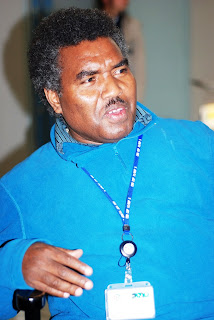18,000 people from around the world gathered recently in Nagoya, Japan at the 10th Conference of the Parties to the Convention on Biological Diversity (CBD COP10).
14 countries in the Pacific are members of the CBD and the “Pacific voice” was well represented in Nagoya.
The Secretariat of the Pacific Regional Environment Programme (SPREP) worked in partnership with Non-Governmental Organisations (NGO’s) in the Pacific region to provide support and advice to the Pacific delegations at Nagoya.
The meeting discussed how to address the dramatic loss of biodiversity currently occurring on earth. In fact one species is being lost every 38 minutes!
Delegates responded with a new commitment to “Live in Harmony with Nature”.
The conference agreed a number of outcomes, which have significance globally and for our Pacific region.
The Strategic Plan of the CBD or the “Aichi Target” was adopted at Nagoya. This is the new global plan to save the World’s biodiversity and includes a number of ambitious targets.
The “Aichi Target” includes a commitment to halve, and where feasible, bring close to zero the loss of natural habitats and also to protect 17% of terrestrial and inland water areas and 10% of marine areas. Also included are measures to control invasive species and to increase awareness of the values of biodiversity.
“We are pleased to welcome the Aichi Target as a guide for our region to work towards,” said David Sheppard, the Director of SPREP.
“The targets are within our reach as the Pacific region has worked diligently to protect our unique biodiversity. We can boast the Phoenix Islands Protected Area (PIPA) in Kiribati - the largest marine protected area on earth - now a World Heritage Site. In our Pacific region we also have the Micronesia Challenge, a commitment by the Federated States of Micronesia, Marshall Islands, Palau, Guam and the Northern Marianas to conserve at least 30% of the near-shore marine resources and 20% of the terrestrial resources across Micronesia by 2020. The “Aichi Target” will help us strengthen our conservation work across the Pacific.”
Another key outcome from the conference was the Nagoya Protocol covering the access to genetic resources and the fair and equitable sharing of benefits from their use.
As an example, and hypothetically, if a pharmaceutical company from Switzerland discovered a plant in the Solomon Islands which could lead to a drug which cured cancer, then that company would now be obliged to share the profits arising with the country.
This historic agreement is of great importance to the Pacific region.
It ensures that balanced access to genetic resources on the basis of prior informed consent and mutually agreed terms. The Nagoya Protocol also ensures the fair and equitable sharing of benefits while taking into account the important role of traditional knowledge.
It is expected the Nagoya Protocol will be in force by 2015. The Global Environment Facility has offered financial support to assist with the early entry into force of this Protocol.
“We have seen history in the making,” said Fiji’s Ambassador to Japan, H.E Mr Isikeli Mataitoga the Head of delegation for Fiji. He added:
“The adoption of the ABS protocol is a major step forward in bringing equity and fairness in the sharing of the profits made by the developed world from the biodiversity resources of the developing world, including the small island developing states.”
The current challenge for Pacific countries is to translate these key outcomes into national biodiversity strategies and to secure support from the international community for their implementation.
Many substantial commitments were made by countries at Nagoya, including a commitment by the Government of Japan of $2billion US to help developing countries protect their biodiversity
“For us in this region, it means working towards identifying opportunities and innovative ways to take these outcomes forward. We have agreed to the Aichi Target now we need to see how and where we can incorporate the different objectives into work we are doing at the national and regional level in the Pacific,” said Easter Galuvao, the Biodiversity Adviser of SPREP.
“In some cases we are on track with the targets, in other cases we need to work harder in a concerted and holistic manner as a region so that by 2020, the Pacific region can once again showcase to the world what we have accomplished as part of our contribution to save our biodiversity.”
These are just several of the many achievements of the biodiversity conference in Nagoya.
There were many more for the Pacific region. Representation from the region ensured a strong Pacific presence was felt and heard as they were a vocal part of the negotiations.
A communications campaign – “The Pacific Voyage” helped ensure Pacific visibility was high and our voices heard at the gathering of 18,000 participants with promotional materials and events which highlighted conservation successes in the Pacific as well as an event which promoted the different types of communication and awareness raising activities on nature conservation.
For SPREP the meeting has helped provide the guide for future work with the different member countries as the region strives to meet the Aichi Targets to help save global biodiversity.
Notes:
To read the full 2020 Headline Targets – Advance Unedited Text please visit Strategic Plan for Biodiversity, 2011 - 2020: http://www.cbd.int/nagoya/outcomes/
The 14 Pacific island parties to the CBD are Cook Islands, Federated States of Micronesia, Fiji, Kiribati, Marshall Islands, Niue, Nauru, Palau, Papua New Guinea, Samoa, Solomon Islands, Tonga Tuvalu, Vanuatu.
Our core partners who worked closely with us as part of the Pacific Voyage in Nagoya are The Secretariat of the Pacific Community, WWF South Pacific, Greenpeace Pacific, Wildlife Conservation Society, IUCN Oceania.


































